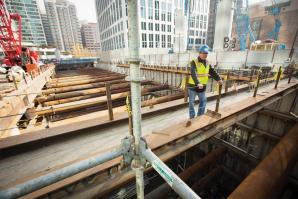During the building boom, contractors had to keep a sharp eye on the rising cost of materials if they wanted to make a decent profit. From 2004 to 2008, double-digit increases were the norm for many products.
Now that building activity has slacked off, contractors have to watch prices more carefully than ever. Costs are still climbing at a time when contractors have to keep margins razor thin to win jobs.
As of June, the year-over-year rise in prices was the highest in three years, according to the Associated General Contractors of America. Including all construction materials, prices were up 8.3 percent from summer 2010.
Blame petroleum products and metals for most of the increase, especially diesel fuel, copper, brass and aluminum. June prices for diesel were up 50 percent from a year earlier. Copper and brass rose 26 percent in the same period, and aluminum 17 percent.
Steel had a comparatively modest climb of only 7 percent in price.
“These are all items that there is worldwide demand for,” says Ken Simonson, chief economist for Associated General Contractors of America.
The same materials go into machinery and consumer goods; a slack construction industry doesn’t reduce demand enough to hold down prices.
It’s a different story for items where construction is the major user. The level of spending this past spring was the lowest since 1999, Simonson says. Prices for construction-specific items obeyed the law of supply and demand. Brick and structural clay tile fell 3.2 percent from summer 2010 to this past June. Lumber and plywood were down 1.4 percent. Gypsum was 7.4 percent cheaper.
But weave it all together, and the cost of materials to build a building rose twice as fast as the consumer price index.
The one bright spot is that materials are available if a developer wants to pay the price. During the boom, so much concrete and steel headed off to the Far East that suppliers had trouble filling U.S. orders.
Countries like China have now built their own capacity to produce many of the materials they need, says Paul Cunha, vice president of general contractor S.D. Deacon Corp. of California in Citrus Heights. The amount of scrap metal headed to China seems to have stabilized as well. And because of globalization, a contractor doesn’t have to worry as much anymore about a hurricane in the Gulf Coast making lumber prices spike, he says.
“My personal feeling is that it is mitigated because we don’t really have the demand, but it will be magnified when we do have the demand,” Cunha says.
This time around, the only scarce item is tires for heavy equipment, thanks to global demand for mining equipment, Simonson says.
But while supply is stable and overall price increases are still in single digits, the desire to land a contract adds to the risk.
“A problem for contractors is that there has been so little work out there that the bidding has been really fierce to get orders,” Simonson says. “Most contractors have had to absorb these price increases. They haven’t been passing them through in bid prices.”
So while materials costs have climbed twice as fast as consumer prices, the cost of a finished building has hardly budged.
The producer price index for buildings of all kinds has risen only 2 percent in the past year, Simonson says. For new industrial building construction, the finished cost went up only 1 percent.
A couple of other elements put the squeeze on contractors. High diesel prices mean there’s often a delivery surcharge.
And tougher government regulations add a different kind of surcharge. Contractors can no longer leave steel reinforcing bars sitting out in the open, says Ed Puchi, treasurer and general counsel of MCM Construction Inc., which specializes in heavy highway and bridge projects. Rain makes the steel rust, and it can soak into the groundwater. So it must be covered, which increases the cost of storing the rebar. Lumber mills now have to vacuum up sawdust and dispose of it, and that cost gets passed along too, he says.
“You can plan for it unless the regulations hit you in midcourse of a contract,” Puchi says. “There is no way to recover that cost.” If the contractor is to make back the money, it has to come from the next contract. And the way to get that next project is to bid low.
“The problem we see with reducing your margin significantly just to keep busy, you end up forcing the market down and it’s very difficult to recover,” Puchi says.
Ken Wenham, president of Roebbelen Contracting Inc. in El Dorado Hills, says: “We are locked in at a price, and there is not any contingency allowed in these projects. You are not going to be competitive with a contingency. We can’t absorb the escalation. That’s why we have to be real upfront with our subcontractors really early on.”
Developers know contractors are hungry for work, so they budget projects accordingly. Sometimes they shoot themselves in the foot.
Thinking that a particular project might have cost $10 million back in 2008, the developer might be sure he can get it done for $6 million today, Wenham says. Then when the bids come in at $8 million, the whole thing is put on hold or scrapped. If the contractor is lucky, the work won’t start. It’s much worse when the project is canceled after the work has started. The materials are ordered and delivered to the job site, but the checks stop.
“As with any project, if you are the contractor and you cease to be paid, you file a lien on the project, which in almost all cases you are subordinate to the lender,” Cunha says. “A prudent contractor will look to see who the lender is and make sure there is money set aside for payment.”
But waiting for money cramps the contractor’s ability to get other jobs.
While materials costs have climbed twice as fast as consumer prices, the cost of a finished building has hardly budged.
“Our company [has] the reputation of not having significant problems in that regard,” Cunha says. “We pay our bills because we make sure we know who we are dealing with. But it can break a contractor. It has done that.”
Even finishing the project is no guarantee of payment. Just ask MCM about the new Fifth Street bridge at the railyards in downtown Sacramento.
“We completed construction on that project in April,” Puchi says. “We have not been paid the final $1 million. The people who get hurt are the manufacturers, the materials suppliers, the subcontractors and the contractors.” MCM has paid its concrete subcontractor but hasn’t paid the rebar subcontractor. In turn, Puchi says he doesn’t know if that sub has paid the rebar manufacturer.
Small businesses have the hardest time absorbing the hit because of their limited cash flow — the same small businesses that MCM is required by contract to include on its team. MCM itself has enough backlog of work to keep going while waiting for final payment, Puchi says.
It used to be that when the private sector sagged, contractors could shift their attention to public works. Now, even that’s a question mark.
At the federal level, Congress stalled $2.5 billion in airport construction projects earlier this year by squabbling over funding for the Federal Aviation Administration.
“Going forward, it looks like Congress may cut back sharply for highways,” Simonson says.
Local governments are even more pressed to deal with deficits, meaning more projects are shelved.
But at least governments tend to finish what they start.
“The only time we have ever seen a project terminated by a government agency is due to environmental regulations,” Puchi says.
Of all those factors, about the only one a contractor can control is properly pricing materials.
“We were just having that discussion,” Wenham says. “Do we have a handle on it? Do we know where the prices are going to be? No. We are working with clients on budget numbers, we can look at the CPI and look at projections based on history but it is really anybody’s guess where we are going to be.”
Looking six months ahead isn’t too hard, but projecting out a couple of years — the length of a major building project — is a lot more difficult, he says.
The only sure course is to lock in prices with the manufacturers as soon as a contract comes in, contractors agree. That means keeping the lines of communication open, both with the suppliers and with the developer.
Delaying the award of a contract could affect the price.
The manufacturers, too, struggle with smaller crews.
“We’ll have owners say, ‘In these times, can’t you just get that steel or that door made overnight?’ But the factories have ‘right sized,’” Wenham says.
What used to take eight weeks to procure might take 10 weeks now because the factories are running with smaller crews. And they aren’t going to hire extra people just to rush an order through, Wenham says.
Contractors are just waiting for a sign that will justify adding an escalation clause to contracts, so that if prices go up beyond a set point, the job would qualify for a change order and thus, an extra charge to the developer.
But the market doesn’t justify it yet, and there’s no telling when it will. So contractors take their best shots with the pricing information that they have and hope they guess right.
“We’re a business of averages,” Wenham says. “It’s a balancing act.”
Recommended For You

Putting the Fab in Pre-Fab
Modular construction cuts construction and energy costs
The final stages of construction at a trend-setting apartment project in San Francisco’s SoMa neighborhood, known by its address at 38 Harriett St., largely resembled a life-sized game of Tetris.




